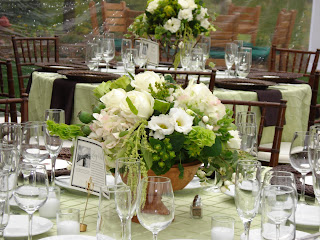 White has a clarifying effect on our psyches. It is the color of purity, clarity, and new beginnings. Floral design based around white will generally produce a serene environment in which people will enjoy spending time in.
White has a clarifying effect on our psyches. It is the color of purity, clarity, and new beginnings. Floral design based around white will generally produce a serene environment in which people will enjoy spending time in.Thursday, May 28, 2009
Psychology of Color: White
 White has a clarifying effect on our psyches. It is the color of purity, clarity, and new beginnings. Floral design based around white will generally produce a serene environment in which people will enjoy spending time in.
White has a clarifying effect on our psyches. It is the color of purity, clarity, and new beginnings. Floral design based around white will generally produce a serene environment in which people will enjoy spending time in.Tuesday, May 26, 2009
Spring Wedding: Part 4: The Finale
Monday, May 25, 2009
Spring Wedding: Part 3: The Centerpieces
Spring Wedding: Part Two: The Celebration
Sunday, May 24, 2009
Spring Wedding: Part 1, Meadow Ceremony

Spring,
Friday, May 22, 2009
Events: Graduation Party
 Graduation is a very exciting time in life. It marks the conclusion of one phase, and the commencement of a new one. Celebrations abound. Appetizers circulate, drinks are held up in heartfelt toasts, guests greatly admire the stunning flowers highlighting the festivities.
Graduation is a very exciting time in life. It marks the conclusion of one phase, and the commencement of a new one. Celebrations abound. Appetizers circulate, drinks are held up in heartfelt toasts, guests greatly admire the stunning flowers highlighting the festivities.Psychology of Color: Yellow
Thursday, May 21, 2009
Flower Tips: Tulips

Spring blooms, such as tulips, hyacinth and daffodils prefer cool water in their vases. Changing the water every day or so, and adding floral preservative will help them to last longer. Blooming branches, such as forsythia, quince, flowering plum and flowering cherry should be re- cut with sharp pruning shears and placed in warm water. To hasten the blooming process of forced branches, place them in a warm area, or you may place a plastic bag over them to create a"greenhouse" effect.
Tulips have a phototropic response, which means they respond to light. I always enjoy watching the tulips "travel", move around in the vase and stretch. It is a delight to see how they rearrange themselves from day to day. To straighten tulip stems upon arrival, we wrap the heads loosely in white tissue paper, recut them and place them in our cooler. The next day, we remove the wrapping, and -Voila!- straight stems.
You can do this with the tulips you bring home, as well. If you cut fresh tulips out of your garden, wrap the heads loosely in tissue paper, making sure the necks are braced, re-cut the stems with a sharp knife and place in clean, cool water. Store them like this overnight in a cool place. In the morning, change out the water, re-cut the stems, and enjoy your beautiful tulips.
*To prolong any cut flower change the water daily, and re-cut the stems using a sharp knife. Dirty water breeds bacteria, and will ruin the flowers quickly. Scissors can just crush or tear the stems, which will inhibit them from getting sufficient water.



































